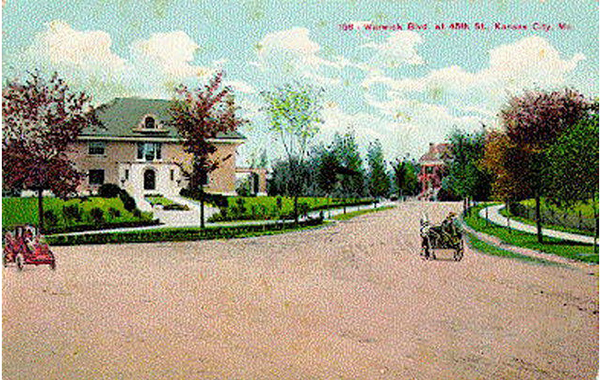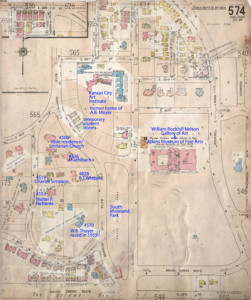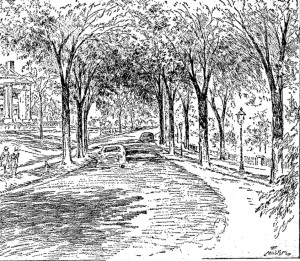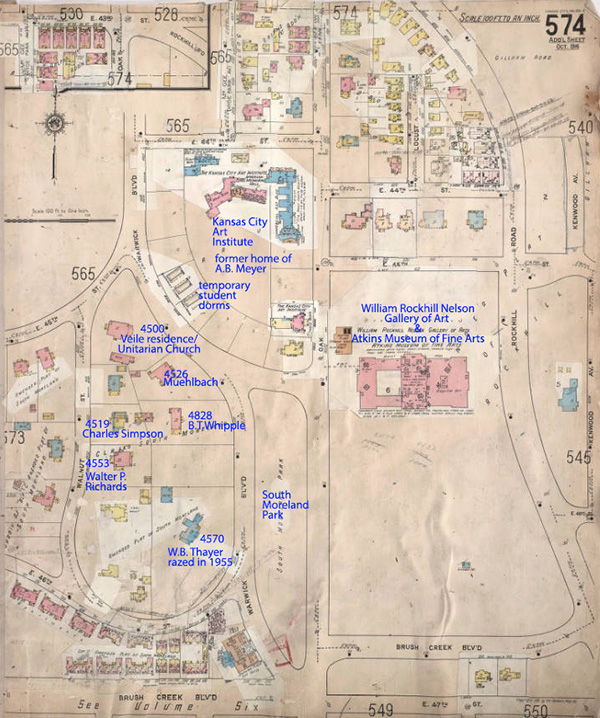
The heyday of the 4500 block of Warwick Boulevard lasted from the early 1900s to the 1940s, when the “old timers” moved on south to newer parts of Kansas City. For that period, however, this block was home to captains of industry and their socialite wives. Even after they left, the street retained an air of “dignity and exclusiveness,” a newspaper reported in 1945, “perhaps because of its venerable trees.”

See a larger map at the end of this post
In the early 1900s, residents included the Stephen Veile family at 4500 Warwick, a home considered one of the most beautiful in the city.
At 4538 Warwick, real estate operator B.T. Whipple lived with his family. Whipple arrived in Kansas City in 1875 and, with his brother, purchased the Mail, an evening paper they later sold to William Rockhill Nelson.
By the way, Nelson lived just across Warwick in Oak Hall until he died, leaving the property as the home of the Nelson-Atkins Museum of Art. August Meyer, best known as the first president of the Parks and Boulevard system, lived just to the north in his huge home, which later became part of the Kansas City Art Institute.
On the southern curve of Warwick at 4570 Warwick, W. B. Thayer of the Emery, Bird & Thayer dry goods company had his massive home razed in 1955.

A Kansas City Star artist, in this 1945 drawing, captured Warwick from a spot facing north with the grounds of the Kansas City Art Institute on the right and a glimpse of the George E. Richards home to the left.
Like many wealthy Kansas City families, the residents of this block of Warwick moved south as Kansas City grew in the 1940s. As they did, the Kansas City Star in 1945 reported that most of the old-timers had “drifted south,” with some old homes being replaced by apartment buildings.
“But the street manages to retain its venerable air of dignity and exclusiveness – perhaps chiefly because of its venerable trees. Those trees were planted personally by Peter Larson, now building superintendent of the Star, at the direction of Mr. Nelson, who footed the bill. Larson obtained the saplings, he said, from an assortment growing in the Shawnee Mission neighborhood and, when he planed them, built boxes around each tree to keep wandering cows from injuring them. Existence of the noble elms has checked more than one street-widening project on Warwick.”
As part of our Uncovering History Project, the Midtown KC Post is examining each block in Midtown. A set of 1940 tax assessment photos is available for many blocks.

We used to live in the Sophian and our windows looked out to Oak Hall. I always wondered what the house there had looked like — this, I guess?
https://www.stcroixarchitecture.com/products/house-of-w-b-thayer-esq-kansas-city-mo-1903-original-plan-root-stevens